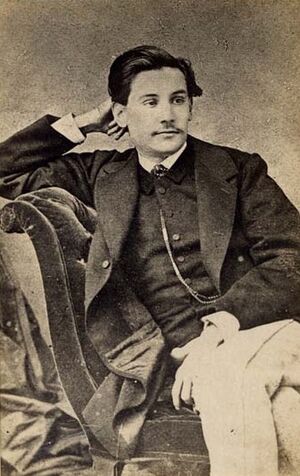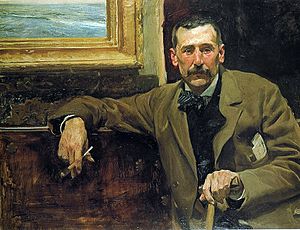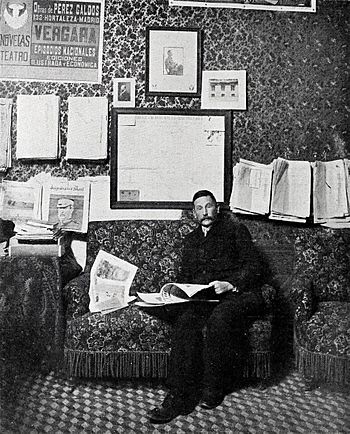Benito Pérez Galdós facts for kids
Quick facts for kids
Benito Pérez Galdós
|
|
|---|---|
 |
|
| Born | Benito María de los Dolores Pérez Galdós 10 May 1843 Las Palmas de Gran Canaria, Canary Islands, Spain |
| Died | 4 January 1920 (aged 76) Madrid, Spain |
| Occupation | Novelist, playwright, politician |
| Literary movement | Realism |
Benito Pérez Galdós (born May 10, 1843 – died January 4, 1920) was a famous Spanish writer. He was known for his realist novels. Many people think he was the most important Spanish writer of the 1800s. Some even say he was second only to Miguel de Cervantes, who wrote Don Quixote.
Pérez Galdós wrote a lot! He published 31 novels, 46 Episodios Nacionales (National Episodes), and 23 plays. He also wrote many short stories and newspaper articles. He is still very popular in Spain today. People often compare him to famous writers like Charles Dickens, Honoré de Balzac, and Leo Tolstoy. Some of his books have been translated into English, and he is becoming more known around the world.
While his plays are not as famous as his novels, his play Realidad (1892) was very important. It helped bring a realistic style to Spanish theater.
You can visit the Pérez Galdós museum in Las Palmas, Gran Canaria. Inside, you can see a painting of him by the artist Joaquín Sorolla.
Pérez Galdós was nominated for the Nobel Prize for Literature in 1912. However, some conservative groups in Spain did not like his views. He often spoke out against the power of the church. Because of this, he did not win the prize.
He was also interested in politics, even though he did not see himself as a politician. He started with liberal ideas, then moved towards being a republican, and later supported socialism. In 1886, he became a representative for Guayama, Puerto Rico. Later, in the early 1900s, he represented Madrid in the Spanish parliament. In 1914, he was elected to represent Las Palmas.
Contents
Early Life and Education
Benito Pérez Galdós was born on May 10, 1843, in Las Palmas de Gran Canaria. He was the tenth and last child of Sebastián Pérez and Dolores Galdós. His family home is now a museum, the Casa-Museo Pérez Galdós.
He went to the San Agustín school. His teachers there taught him to think critically and love history, art, and literature. In 1862, he finished his high school studies. He then traveled to Tenerife to get his arts certificate. That same year, he moved to Madrid to study law. But he never finished his law degree.
While in Madrid, he spent time with writers and artists. He walked around the city a lot, learning about daily life and seeing important political events. These experiences helped him write his first novels, The Golden Fountain Café (1870) and El audaz (1871).
Life as a Writer
Benito Pérez Galdós lived a comfortable life. He often lived with his sisters or his nephew.
He had a special writing routine. He would wake up early and write until 10 AM, always using a pencil. He thought using a pen wasted time. After writing, he would walk around Madrid. He would listen to people's conversations and notice small details. This helped him create realistic dialogues and descriptions in his novels.
In the afternoons, he read books in Spanish, English, or French. He especially loved classic writers like William Shakespeare, Charles Dickens, Miguel de Cervantes, Lope de Vega, and Euripides. Later in life, he also started reading Leo Tolstoy. He loved music and often went to concerts. He usually went to bed early and rarely went to the theater.
According to writer Ramón Pérez de Ayala, Pérez Galdós dressed simply. He wore dark clothes to blend in. In winter, he often wore a white woolen scarf. He usually had a half-smoked cigar in his hand. When he sat down, his German shepherd dog was often by his side. He kept his hair very short and often suffered from bad headaches.
By 1865, he was writing articles for a newspaper called La Nación. He wrote about literature, art, music, and politics. It became clear he would not become a lawyer. His first attempt at writing a play in 1867 was not successful. He didn't try writing for the theater again until 1892.
He loved the novels of Charles Dickens. In 1868, he translated Dickens' Pickwick Papers into Spanish. This helped introduce Dickens' work to Spain. The year before, he had visited Paris and started reading the works of Honoré de Balzac. In 1870, he became an editor for La Revista de España. Here, he shared his thoughts on many topics.
Between 1867 and 1868, he wrote his first novel, La Fontana de Oro. It was a historical story set between 1820 and 1823. With help from his sister-in-law, it was published in 1870. At first, it didn't get much attention. But eventually, it was praised as a new and important Spanish novel. People liked its literary quality and its social message.
National Episodes
Pérez Galdós then started a huge project called the Episodios Nacionales. This was a series of historical novels. They told the story of important events in Spanish history, from the Battle of Trafalgar in 1805 up to his own time.
The writer Max Aub said that if all other historical records from the 1800s were lost, Galdós's work would be enough. He said Galdós captured the "complete, alive, real life of the nation" during that century. Aub believed Galdós, like Tolstoy, showed the spirit of his homeland through its struggles and triumphs.
The first book in the series was Trafalgar, published in 1873. He continued writing these episodes until the forty-sixth and final novel, Cánovas, appeared in 1912. Sometimes, Pérez Galdós felt tired of the project and said he would stop. But people loved these books and bought them eagerly. They were a main source of his fame and income.
He did a lot of research for these stories. Official reports and newspapers were often biased. To get a balanced view, Pérez Galdós talked to people who had lived through the events. For example, for Trafalgar, he spoke with an old man who had been a cabin boy on a ship during the battle. Pérez Galdós often questioned official versions of history. He sometimes had problems with the Catholic Church, which was very powerful in Spain at the time.
Other Novels
A literary expert named José Montesinos divided Galdós's other novels into groups:
- Early works: These include novels from La Fontana de Oro to La familia de León Roch (1878). One of the most famous is Doña Perfecta (1876). It tells the story of a young, modern man arriving in a very religious town. In Marianela (1878), a young man who was blind regains his sight. He then rejects his best friend Marianela because he finds her unattractive.
- Contemporary Spanish Novels: This group includes 22 novels written from La desheredada (1881) to Angel Guerra (1891). These are considered his most important works. His masterpiece, Fortunata y Jacinta (1886–87), is in this group. These novels are connected by characters who appear in different stories, a style he learned from Balzac. Fortunata y Jacinta is a very long book, almost as long as War and Peace. It follows four main characters: a young man, his wife, his mistress, and her husband. The character of Fortunata was inspired by a real girl Pérez Galdós saw drinking a raw egg in Madrid.
- Later novels: These focus more on understanding people's minds. Many of them are written as conversations between characters.
Influences and Style
Pérez Galdós loved to travel. His novels show that he knew a lot about Madrid and many other cities and towns in Spain. For example, he described Toledo in his novel Angel Guerra. He visited Great Britain many times, starting in 1883.
His descriptions of Madrid's different areas and its ordinary people, especially in Fortunata y Jacinta, are similar to the styles of Dickens and French realist writers like Balzac. Pérez Galdós also showed interest in technology and crafts. For instance, he wrote detailed descriptions of a rope factory in La desheredada. He also described how the main character in La de Bringas (1884) embroidered pictures using hair.
He was also inspired by Émile Zola and Naturalism. This style of writing tried to show how people's lives were shaped by their family background, surroundings, and social conditions. These writers also wanted their works to be like scientific studies of society. You can see these influences clearly in Lo prohibido (1884–85). This novel is also special because it's told by a narrator who isn't always reliable and who dies during the story.
Another influence came from the ideas of Karl Christian Friedrich Krause. These ideas became popular in Spain thanks to the educator Francisco Giner de los Ríos. Galdós's novel El Amigo Manso (1882) shows this influence. The mystical side of Krause's philosophy also led Galdós to be interested in mental illness. He explored the idea that people who seem mad can sometimes have strange wisdom. This became an important theme in his later works, like Miau (1888) and his last novel La razón de la sinrazón.
Throughout his writing career, Pérez Galdós often angered the Catholic press. He criticized what he saw as the misuse of religious power. However, he did not attack religious faith itself. In fact, the need for faith is important in many of his novels. He also created many kind and understanding characters who were priests and nuns.
Return to the Theater
His first important play was Realidad. It was based on his novel of the same name, which was already written in dialogue form. Pérez Galdós liked the idea of connecting directly with his audience. He wanted to see and hear their reactions. Rehearsals for the play began in February 1892. The theater was full on opening night, and the audience loved the play. Pérez Galdós took about 15 bows.
However, not all critics liked the play. They found its realistic dialogue different from the usual theater language of the time. The Catholic press did not even attend the show, but they still criticized the author. They called him a bad influence. The play ran for twenty nights.
In 1901, his play Electra caused a huge stir. It led to both strong anger and great excitement. Like in many of his works, Pérez Galdós criticized religious fanaticism and old superstitions. During the performance, the audience reacted strongly. The author had to take many bows. After the third night, conservative and religious groups organized a protest outside the theater. The police got involved, and some people were hurt. The next day, newspapers were divided, with liberals supporting the play and conservatives condemning it. The play was performed over a hundred times in Madrid and also in other cities. In 1934, 33 years later, a new performance in Madrid caused similar strong reactions.
Later Life and Politics
Even though he criticized conservative forces, Pérez Galdós was not very interested in being directly involved in politics. In 1886, the Prime Minister Práxedes Mateo Sagasta appointed him as a representative for Guayama, Puerto Rico in the Madrid parliament. He never visited Guayama, but he had someone keep him informed about the area. He felt it was his duty to represent its people well. This role lasted five years. It mainly gave him a chance to see how politics worked, which he used in his novels.
Later, Madrid elected Pérez Galdós as a representative in the Cortes in 1907. He was part of the republican political groups. In 1909, he even led a group called the Republican–Socialist Conjunction with Pablo Iglesias. However, Pérez Galdós soon left these political struggles. He said he "did not feel himself a politician" and wanted to focus on his novels and plays.
Around this time, King Alfonso XIII met with Pérez Galdós. This made his political position a bit unclear. However, in 1914, Pérez Galdós, who was ill and blind, ran for election again. He won and became a republican representative for Las Palmas de Gran Canaria.
In March 1914, a national committee was set up to honor Pérez Galdós and help him financially. Important people like the head of the government and a banker joined. However, the Catholic press made fun of him, calling him a "blind beggar." Also, World War I started. Because of these reasons, the plan to raise money for him failed. He was nominated for the Nobel Prize in Literature for five years (1912–1916). Winning would have helped his finances and fame, but he never won.
In 1916, the Ministry of Public Instruction gave him a job to organize the 300th anniversary of Cervantes' death. He received a monthly payment for this. Even though the event never happened, he continued to receive this payment for the rest of his life.
In 1918, he joined Miguel de Unamuno and others to protest against increasing censorship and strict government control.
In 1897, Pérez Galdós was elected to the Real Academia Española, a very important group for the Spanish language. After he became blind, he continued to write his books by dictating them to others. Pérez Galdós died at 76 years old.
Shortly before he died, a statue honoring him was unveiled in the Parque del Buen Retiro, a popular park in Madrid. The statue was paid for by public donations. Pérez Galdós, who was blind, touched the statue's face with his hands. He recognized it and began to cry, telling the sculptor, "Magnificent, my friend Macho, and how she looks like me!"
Works
Early Novels
- La Fontana de Oro (1870)
- La Sombra (1871)
- El Audaz (1871)
- Doña Perfecta (1876)
- Gloria (1877)
- Marianela (1878)
- La Familia de León Roch (1878)
Contemporary Spanish Novels
- La Desheredada (1881)
- El Amigo Manso (1882)
- El Doctor Centeno (1883)
- Tormento (1884)
- La de Bringas (1884)
- Lo Prohibido (1884–85)
- Fortunata y Jacinta (1886–87)
- Celín, Tropiquillos y Theros (1887)
- Miau (1888)
- La Incógnita (1889)
- Torquemada en la Hoguera (1889)
- Realidad (1889)
- Ángel Guerra (1891)
Later Novels
- Tristana (1892)
- Torquemada en la Cruz (1893)
- La Loca de la Casa (1893)
- Torquemada en el Purgatorio (1894)
- Torquemada y San Pedro (1895)
- Nazarín (1895)
- Halma (1895)
- Misericordia (1897)
- El Abuelo (1897)
- Casandra (1905)
- El Caballero Encantado (1909)
- La Razón de la Sinrazón (1915)
Episodios Nacionales
- Episodios Nacionales
Plays
- Realidad (1892)
- La Loca de la Casa (1893)
- Gerona (1893)
- La de San Quintín (1894)
- Los Condenados (1895)
- Voluntad (1896)
- Doña Perfecta (1896)
- La Fiera (1897)
- Electra (1901)
- Alma y Vida (1902)
- Mariucha (1903)
- El Abuelo (1904)
- Barbara (1905)
- Amor y Ciencia (1905)
- Pedro Minio (1908)
- Zaragoza (1908)
- Casandra (1910)
- Celia en los Infiernos (1913)
- Alceste (1914)
- Sor Simona (1915)
- El Tacaño Salomón (1916)
- Santa Juana de Castilla (1918)
Short stories
- Una industria que vive de la muerte. Episodio musical del cólera (1865)
- Necrología de un proto-tipo (1866)
- La conjuración de las palabras. Cuento alegórico (1868)
- El artículo de fondo (1871)
- La mujer del filósofo (1871)
- La novela en el tranvía (1871)
- Un tribunal literario (1872)
- Aquél (1872)
- La pluma en el viento o el viaje de la pluma (1873)
- En un jardín (1876)
- La mula y el buey (1876)
- El verano (1876)
- La princesa y el granuja (1877)
- El mes de junio (1878)
- Theros (1883)
- La tienda-asilo (1886)
- Celín (1889)
- Tropiquillos (1893)
- El Pórtico de la Gloria (1896)
- Rompecabezas (1897)
- Rura (1901)
- Entre copas (1902)
- La república de las letras (1905)
Miscellaneous
- Crónicas de Portugal (1890)
- Discurso de Ingreso en la Real Academia Española (1897)
- Memoranda, Artículos y Cuentos (1906)
- Política Española I (1923)
- Política Española II (1923)
- Arte y Crítica (1923)
- Fisonomías Sociales (1923)
- Nuestro Teatro (1923)
- Cronicón 1883 a 1886 (1924)
- Toledo. Su historia y su Leyenda (1927)
- Viajes y Fantasías (1929)
- Memorias (1930)
Film Adaptations
Many of Pérez Galdós's novels have been made into movies:
- Beauty in Chains (Doña Perfecta) was a 1918 film.
- Viridiana (1961), directed by Luis Buñuel, is based on Halma.
- Buñuel also adapted Nazarín (1959) and Tristana (1970).
- La Duda was filmed in 1972.
- El Abuelo (1998) was released internationally a year later. It had also been made into an Argentine film in 1954.
- In 2018, Sri Lankan director Bennett Rathnayke directed the film Nela.
Pérez Galdós' House-Museum
The Pérez Galdós' House-Museum (Casa-Museo Pérez Galdós) is in the Triana neighborhood of Las Palmas de Gran Canaria. This house is where Galdós was born. It was bought and turned into a museum in 1954. The writer's daughter, María Pérez Galdós Cobián, opened it on July 9, 1960.
At the House-Museum, you can see the house where the writer grew up. There are also documents like letters and manuscripts, furniture, musical instruments, paintings, and photos. These items belonged to Pérez Galdós and his family.
The museum's goal is to keep, study, and share the legacy of Benito Pérez Galdós. To do this, the museum has organized many international conferences and exhibitions. They also offer school visits and publish several collections of his works.
The House-Museum has its own library with many of Galdós's works in different languages. You can also find his complete works in ePub format (in Spanish) and take a virtual tour online.
See also
 In Spanish: Benito Pérez Galdós para niños
In Spanish: Benito Pérez Galdós para niños




